Contents
Market Overview
U.S. fiscal risks are beginning to look fully-priced in U.S. Treasury markets. Hawkish commentary directed at China remains one surprise as Secretary Yellen’s political views became more clear, while the language around “Act Big” was widely anticipated. Treasuries ended the week 1-2 bps wider and were primarily driven by German bunds widening 4 bps post-ECB, while the U.S. dollar ended 0.6% weaker. Rumors that the ECB may introduce an explicit yield spread limit and the BoJ may scrap yield curve controls, ultimately failed to materialize. Instead renewed lockdown risks in Asia and Yellen’s comments kept CNH subdued as the currency edged closer to 6.50. EM credit ended the week up 0.2% with spreads 3 bps tighter, with the IG/HY compression theme returning (EM IG tightened 2 bps with EM HY tightening 5 bps). The biggest winners this week were Sri Lanka, Georgia and Suriname as Lebanon, Zambia and Ecuador lagged. EM local currency had another strong week and clocked the largest weekly inflows since 2012 ($2.8bn), ending the week up 0.6% as South African rand assets outperformed considerably. The main theme aside from U.S. Treasury volatility rests with supply, and whether this leads to any indigestion. A bulk of the EM primary supply was from corporates this month, with $61bn year-to-date, where 61% is IG-rated and $40bn is from Asia issuers.
Key EM themes into next week – aside from the FOMC and IMF updated growth outlook – include rate decisions out of Colombia (1.75%), Hungary (0.6%), Kazakhstan (9.0%), Kenya (7.0%) and Nigeria (11.5%). Manufacturing PMIs from China and Thailand also stand-out, after weaker flash PMIs from the UK and Eurozone. Beyond that, we can expect Poland and Russia’s industrial output with Brazil’s budget on Monday followed by South Africa’s later in the week. Other events include Hungary’s unemployment data and Turkey’s trade deficit release after holding rates unchanged at 17.0%.
Fixed Income
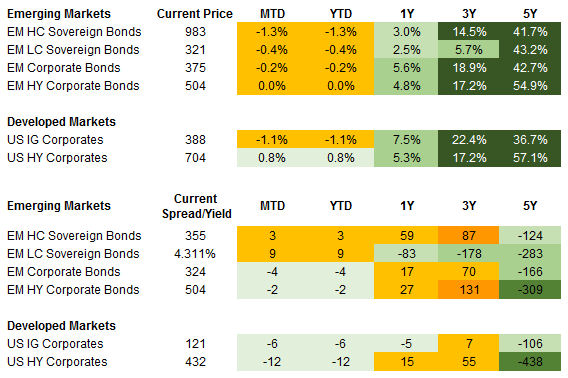
Equities
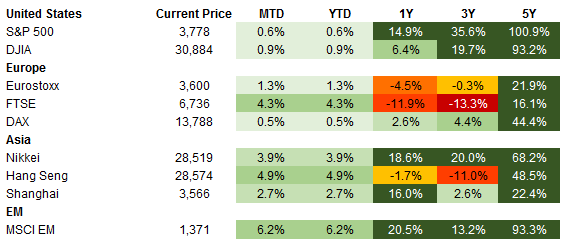
Commodities

Source for data tables: Bloomberg, JPMorgan, Gramercy. EM Fixed Income is represented by the following JPMorgan Indicies: EMBI Global, GBI-EM Global Diversified, CEMBI Broad Diversified and CEMBI Broad High Yield. DM Fixed Income is represented by the JPMorgan JULI Total Return Index and Domestic High Yield Index. Fixed Income, Equity and Commodity data is as of January 22, 2021 (Mid Afternoon).
Emerging Markets Weekly Highlights
China’s real GDP growth returned to pre-COVID-19 trends in 4Q albeit recovery remains uneven; Turkey’s Central Bank remains hawkish, notwithstanding President Erdogan’s recent remarks; Uncertainty prevails two weeks before the first round of Ecuador’s presidential and general elections amid confusing polls and a large share of undecided voters; YPF, Argentina’s state-controlled energy company, amends consent procedure in exchange offer.
China’s real GDP growth returned to pre-COVID-19 trends in 4Q albeit recovery remains uneven
Event: The Chinese economy expanded 6.5% y/y in real terms in the fourth quarter of 2020 compared to 4.9% y/y in the previous quarter and 5.8% in 4Q 2019. Overall 2020 real GDP growth was 2.3% y/y led by investment and net exports with a drag from consumption. Services output has been mixed with a solid aggregate rise of 7.7% y/y in December vs. 6.8% in December 2019. However, retail sales data remains soft with particular weakness in the worst hit sectors such as hotels and restaurants. A recent rise in virus cases has led to localized tightening of restrictions.
Gramercy commentary: We expect solid external sector and investment performance in the first half of this year to continue to provide a tailwind for emerging markets recovery and commodities albeit likely to a lesser extent than in 2H20 on easing sequential growth. The consumer sector recovery may face renewed, albeit comparatively moderate, headwinds in 1Q on virus management. As vaccine rollout gains momentum in 2H20, the outlook for a more complete recovery in services should improve but be partially offset by incremental headwinds from currency strength, property sector tightening and a gradual reduction of fiscal stimulus and credit growth. While tariff rollback by the Biden Administration is not expected imminently, there are prospects for this later in the year, which would be supportive for growth.
Turkey’s Central Bank remains hawkish, notwithstanding President Erdogan’s recent remarks
Event: After delivering 675 bps of monetary tightening at its previous two policy meetings in November and December, respectively, the Central Bank of Turkey (CBRT) paused this week, holding its main rate (1-wk repo rate) at 17%. However, the CBRT struck a distinctly hawkish tone, committing to “maintain tight policy stance for an extended period” and “deliver additional monetary tightening if needed”.
Gramercy commentary: CBRT’s messaging continues to reinforce a material market-friendly shift in policy direction under the new leadership that took over in November 2020. The main market relevance of this week’s monetary policy meeting was in the CBRT’s forward guidance, and the Bank delivered strongly. Specifically, in the context of President Erdogan’s comments last week reiterating his unorthodox views on economic policy, interest rates and inflation, some market participants might have started to worry that CBRT’s political window of opportunity for its pragmatic policy U-turn might be closing and even that a premature monetary policy easing might be forthcoming. We believe the clear message from this week’s monetary policy meeting should not only dispel such investor concerns, but actually send an even stronger signal to markets on CBRT’s willingness and ability to keep monetary policy tight as long as necessary to deliver sustained lower inflation. We expect CBRT’s constructive policy stance to continue to support the gradual rebuilding of market confidence and Turkish assets, especially local currency ones. As we have previously written, we expect tailwinds for the Turkish lira (TRY) to materialize from the gradual de-dollarization of local bank deposits (supported by higher onshore real interest rates) and a continued recovery in the economy’s external accounts as global economic activity normalizes with broader vaccine deployment in the coming months.
Uncertainty prevails two weeks before the first round of Ecuador’s presidential and general elections amid confusing polls and a large share of undecided voters
Event: Ecuador goes to the polls on February 7th for presidential and parliamentary elections that will determine the future trajectory of economic policy and cooperation with the IMF and carry a material market significance.
Gramercy commentary: Ecuadorian pre-election polls have a poor track record and have been particularly confusing in this election season, but we think the most likely scenario is that the presidential race will be decided in a runoff in April between market-friendly center-right candidate, Guillermo Lasso, and populist leftist candidate, Andrés Arauz, who is supported by former President, Rafael Correa. The binary and highly unpredictable nature of the presidential race has clearly been a major market concern, reflected by Ecuador’s recent underperformance in the EM HY sovereign space. We acknowledge the uncertainty that will likely continue to dampen market sentiment in the pre-election environment, but believe the lack of market sponsorship on Ecuador overlooks a number of structural factors that will likely support the credit story, even in the event the Correista/populist candidate wins the presidency. We are of the opinion that a number of strong incentives exist for any new administration, regardless of its ideological bias, to preserve the economic benefits of Ecuador’s excellent cooperation with the IMF and the very significant liquidity relief secured by the sovereign through the successful debt restructuring completed last year. Most importantly, we are firm believers that any future economic policy decisions in Ecuador will continue to be taken through the prism of protecting dollarization, the country’s most cherished economic institution. We think this will foster political and policy pragmatism while the elections are out of the way. Furthermore, investors should not underestimate important geopolitical factors such as the extraordinarily strong economic and foreign policy support that Ecuador has received from the U.S. in recent years. We believe this relationship is best understood in the context of Washington’s efforts to counter strong existing and future Chinese influence in the Western Hemisphere, which is something we do not expect to change with the new White House administration.
YPF, Argentina’s state-controlled energy company, amends consent procedure in exchange offer
Event: Last week, YPF announced a voluntary exchange offer with an exit consent solicitation on its entire USD bond curve. The offer comes on the back of the Central Bank’s FX ordinance, which allows corporates access to dollars for up to 40% of the principal amounts due of USD bond maturities through March 2021. While YPF had already exchanged ~60% of the March 2021 bonds, its liability management exercise had preceded the new FX guidelines; the company was therefore forced to enter into a new exchange for at least its March 2021 bonds. Rather than focusing on the near-term maturity, YPF is offering new Secured 26s and Unsecured 29s and 33s in exchange for its existing bonds. Critically, the new instruments on offer would not pay interest for the first two years. The exchange offer comes with an exit consent solicitation which, if accepted, would leave the existing bonds with a materially reduced covenant package. YPF had originally targeted an aggressive and off-market exit consent procedure. Bondholders repudiated the company’s attempt to force the consent through with an acceptance of as low as 15%, in certain scenarios. This week, YPF amended its consent solicitation procedure. Finally, Chairman Guillermo Nielsen announced that he would step down (but remain involved through the exchange offer). He will be replaced by Pablo Gonzalez.
Gramercy commentary: While the normalization of the consent solicitation procedure is welcome news, YPF has yet to amend the underlying economics of the exchange offer. As it stands, participating bondholders would face a material NPV reduction (with a higher impact for the long-end of the curve); therefore, we do not believe that the current economics will lead to substantial participation. We expect the company to amend the exchange offer to incentivize higher participation in the coming days.
Emerging Markets Technicals
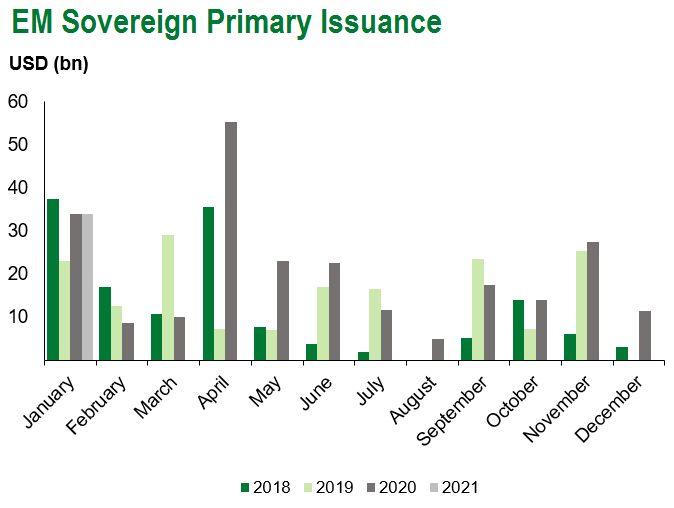
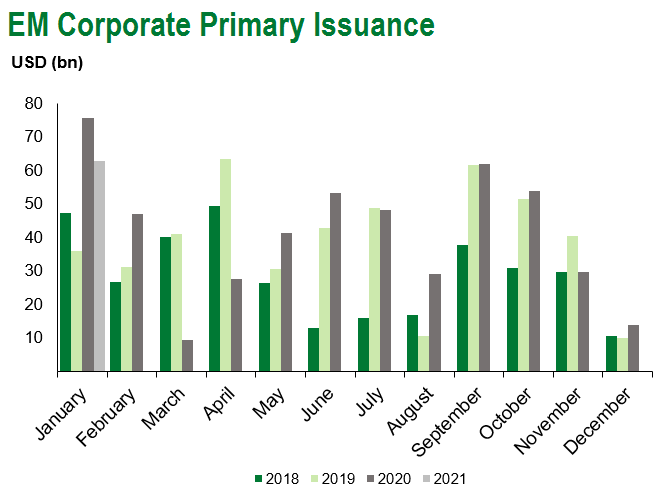
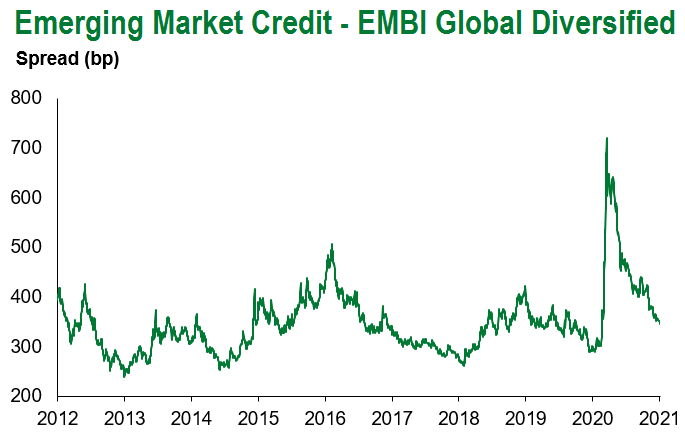
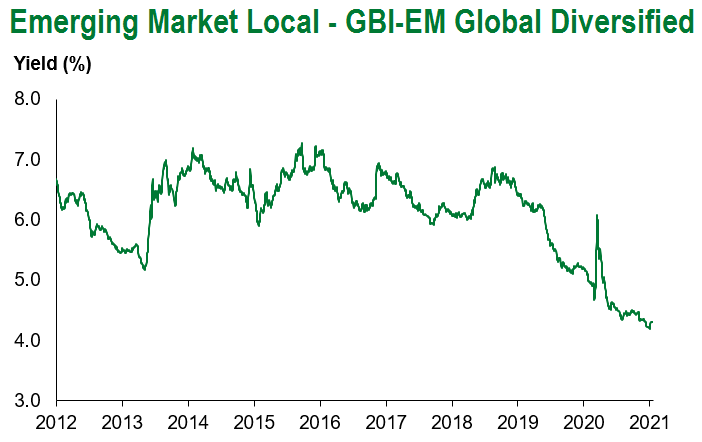
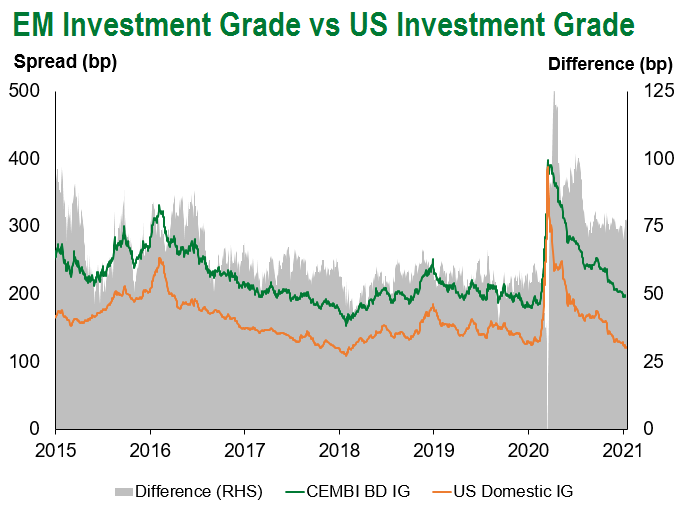
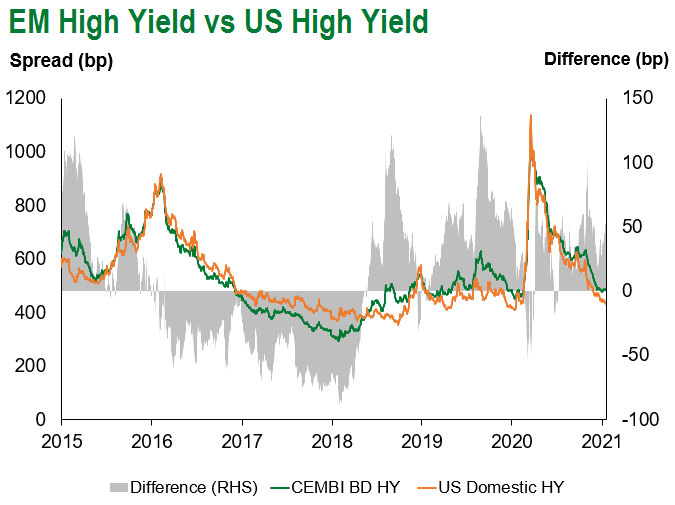
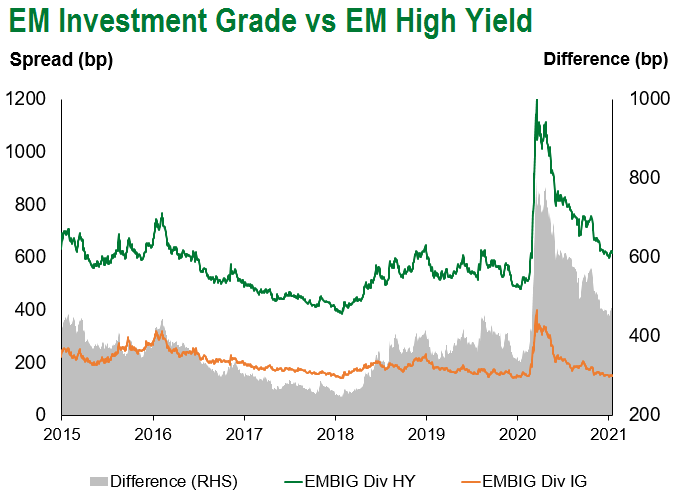
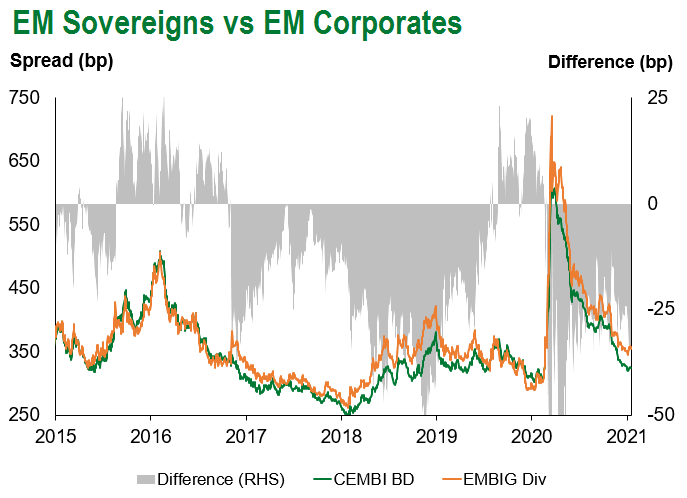
Emerging Markets Flows
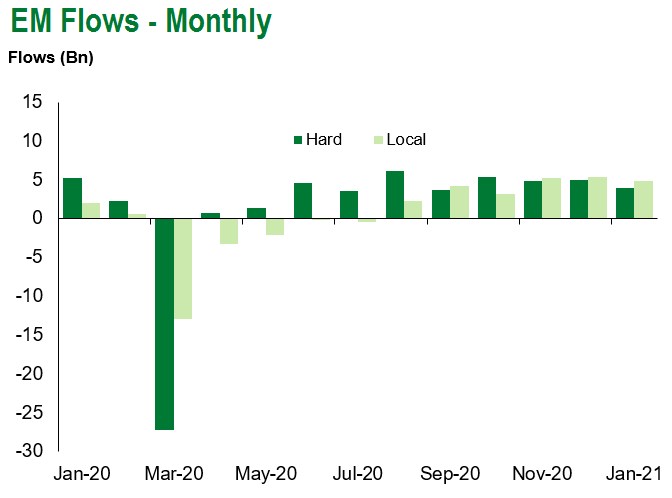
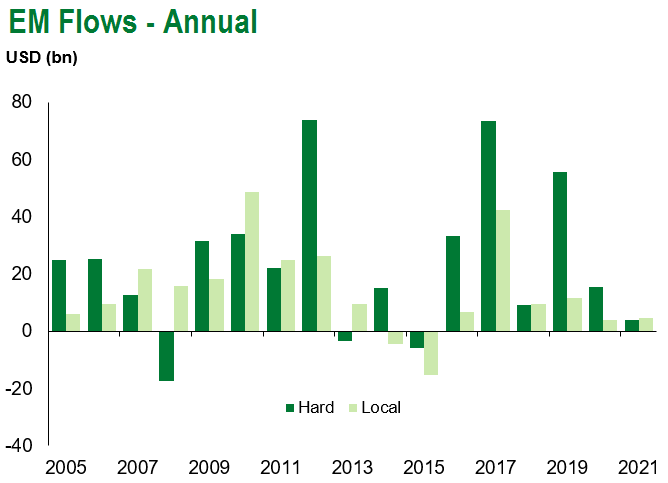
Source for graphs: Bloomberg, JPMorgan, Gramercy. As of January 22, 2021.
COVID Resources
Emerging Markets COVID-19 Case Summary
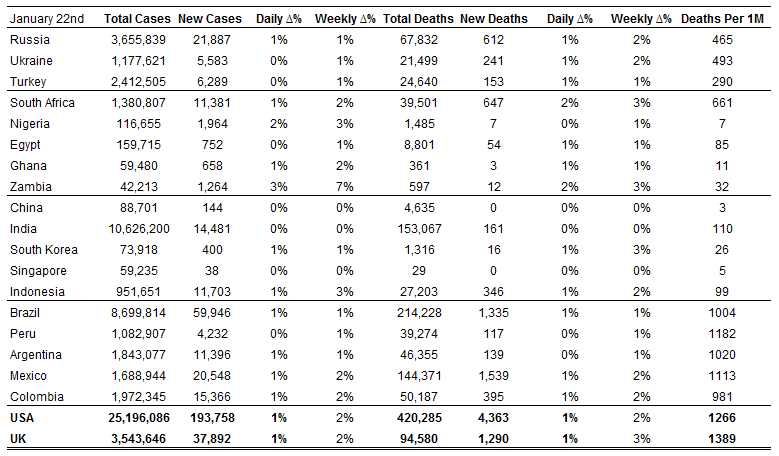
Source: Worldometer as of January 22, 2021.
Additional Crisis Resources:
Johns Hopkins COVID-19 Case Tracker
For questions, please contact:
Kathryn Exum, Senior Vice President, Sovereign Research Analyst, [email protected]
Petar Atanasov, Senior Vice President, Sovereign Research Analyst, [email protected]
Tolu Alamutu,CFA, Senior Vice President, Corporate Research Analyst, [email protected]
James Barry, Vice President, Corporate Research Analyst, [email protected]
This document is for informational purposes only. The information presented is not intended to be relied upon as a forecast, research or investment advice, and is not a recommendation, offer or solicitation to buy or sell any securities or to adopt any investment strategy. Gramercy may have current investment positions in the securities or sovereigns mentioned above. The information and opinions contained in this paper are as of the date of initial publication, derived from proprietary and nonproprietary sources deemed by Gramercy to be reliable, are not necessarily all-inclusive and are not guaranteed as to accuracy. This paper may contain “forward-looking” information that is not purely historical in nature. Such information may include, among other things, projections and forecasts. There is no guarantee that any forecasts made will come to pass. Reliance upon information in this paper is at the sole discretion of the reader. You should not rely on this presentation as the basis upon which to make an investment decision. Investment involves risk. There can be no assurance that investment objectives will be achieved. Investors must be prepared to bear the risk of a total loss of their investment. These risks are often heightened for investments in emerging/developing markets or smaller capital markets. International investing involves risks, including risks related to foreign currency, limited liquidity, less government regulation, and the possibility of substantial volatility due to adverse political, economic or other developments. The information provided herein is neither tax nor legal advice. Investors should speak to their tax professional for specific information regarding their tax situation.